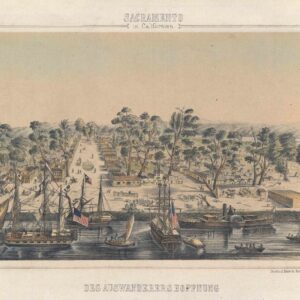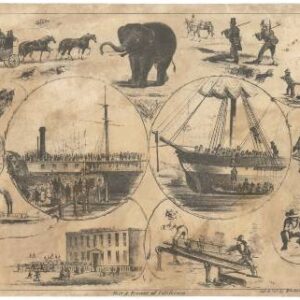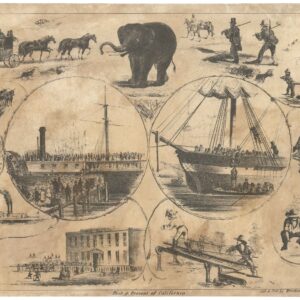Lithographic broadsheet depicting government initiatives to manage California’s water supply.
Central Valley Project — California.
Out of stock
Description
This highly informative multicolor broadsheet shows the federal and state governments’ comprehensive plan to conserve and manage the water supply in California, an initiative known as ‘The Central Valley Project.’ The sheet was published by the Department of the Interior and the Bureau of Reclamation in 1938 and printed by the Baltimore-based lithography company of August Hoen & Co.
Mapping California’s water management
The sheet is divided into two parts of roughly equal size. At the bottom is a striking topographical map of California. Drawn in raised relief at an oblique aerial angle and shaded in vivacious coloring, the map captures the entire infrastructure in place. First and foremost, it defines the Great Central Valley tract that constitutes the locus for the government’s water conservation efforts. Part of this is the delineation of a massive agricultural zone of more than two million acres that is (or will become) dependent on these water-management initiatives.
Most of the catchment area is centered on the Sacramento and San Joaquin Rivers, but the many tributaries also play an evident role. The entire system is visually anchored at either end by the large Shasta and Friant dams, whose hydro-power plants supply the state with electrical power. Important infrastructure such as pumping stations and transmission lines are also clearly shown.
In addition to the features directly relevant to the main purpose of this lithographic sheet, the map is full of lovely details. We note the presence of iconic locations such as Lake Tahoe, Yosemite Valley, the Mojave Desert, the Salton Sea, and the peaks of Mt Whitney, Mt Lassen, and Mt Shasta. Also depicted are California’s most notable urban hubs: Los Angeles, San Francisco, Oakland, Sacramento, Fresno, and Bakersfield.
The government is here to help…
The upper half of the sheet contains the title and headline but is otherwise reserved for a short explanatory essay on the initiatives taken to conserve water. The text is interspersed with black and white photographs that document some of the water conservation initiatives that California was already implementing in the 1930s. This includes the construction of the Friant and Shasta dams, but also examples of what happens when water is not properly managed and the supply fails.
The purpose and goals of managing the Golden State’s water supply are made explicit in the subtitle beneath the headline. In addition to securing a stable supply of potable water for both domestic and industrial purposes, the government’s initiatives were set up to control flooding and salinity levels, secure water for irrigation (and recreation), create electricity, and maintain infrastructure in the form of navigation and mobility on California’s rivers.
Context is Everything
In 1873, Barton S. Alexander presented a report to the U.S. Army Corps of Engineers, which proposed the creation of The Central Valley Project. The main purpose was to transfer water from Northern California to the Central Valley. By 1904, the Bureau of Reclamation began expressing interest in Alexander’s project, but as is often the case with government initiatives, it was delayed and ended up being a reaction to calamity rather than a timely effort to avert it. The delay lasted until the early 1920s when a series of droughts and other water-related catastrophes struck California.
The turning point came in 1933 when the State of California ratified the Central Valley Project Act. This legislation allowed the Bureau of Reclamation to issue revenue bonds, which generated approximately $170 million in funding for the project. Unfortunately, financial setbacks due to insufficient state funds and the economic hardships of the Great Depression caused further delays. Ultimately, California was forced to seek federal funding for the project, which is why it ended up being an initiative that was shared between the state and federal governments and also involving the Army Corps of Engineers.
The initial groundwork commenced in the late 1930s and focussed on the construction of the Friant and Shasta dams and the excavation of a comprehensive network of irrigation canals. This was the start of a multi-decade endeavor that was not fully completed until the early 1970s.
Cartographer(s):
A. Hoen & Co. was a lithographic printing company established in the 1840s by Edward Weber (as E. Weber & Co). Headquartered in Baltimore, the company rose to prominence under the leadership of August Hoen. After Weber’s death, Hoen assumed company control and rebranded the firm as A. Hoen & Co. His dedication to excellence and innovation propelled the company to become a driver of the American lithography and printing industry in the mid-19th century.
In addition to building the company, August Hoen is famous for pioneering the litho-caustic method. Patented in 1860, this revolutionized etching techniques using citric acid and gum arabic blend. This allowed lithographers to monitor the development of shaded patterns as they were etched onto the stone. Hoen’s relentless pursuit of refining shading techniques led to multiple patents granted in 1880 for methods to produce halftone prints via lithography. In 1877, the company gained recognition at the Centennial Exposition with “The Continentals,” a print created by Hoen’s litho-caustic process. It earned a commendation from the expo judges for its excellence in chromo-lithographic art.
Albert Hoen, August’s son, continued in his father’s footsteps and made significant contributions to the field, excelling as a printmaker and overseeing a laboratory dedicated to lithographic limestone testing. He conducted rigorous experiments and test runs with stones from promising new locations, furthering the company’s commitment to innovation and quality.
Condition Description
Wear and toning around edge. Small tear in left margin.
References





